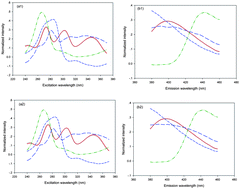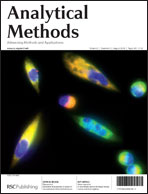An effective excitation-emission fluorescence method was proposed to determine fluphenazine hydrochloride (FPH) in the presence of chlorprothixene (CPT) in human urine samples with the aid of second-order calibration methods based on the full rank parallel factor analysis (FRA-PARAFAC) and parallel factor analysis (PARAFAC) algorithms respectively. FPH can be transformed into a highly fluorescent derivative through oxidation reaction with KMnO4. Both methods have been recommended to attain FPH concentration in urine samples free from interferents of urine matrix, even in the presence of another antipsychotic drug chlorprothixene (CPT). Satisfactory results have been achieved for FPH in predicted samples, fully exploiting “second-order advantage”. The average recoveries of FPH in the urine samples obtained by using both FRA-PARAFAC and PARAFAC with N = 4 are 101.0 ± 2.8% and 102.3 ± 2.8%, respectively. Furthermore, in order to investigate the performance of the proposed methods, some statistical parameters and figures of merit of FRA-PARAFAC and PARAFAC, i.e., sensitivity (SEN), selectivity (SEL) and limit of detection (LOD) were evaluated, and the accuracy of both algorithms was also validated by the elliptical joint confidence region (EJCR) test.

You have access to this article
 Please wait while we load your content...
Something went wrong. Try again?
Please wait while we load your content...
Something went wrong. Try again?


 Please wait while we load your content...
Please wait while we load your content...